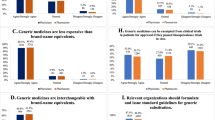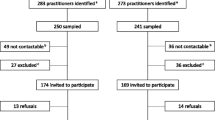Abstract
Background Patients, physicians and pharmacists are key stakeholders in the implementation of generic substitution policies. Objectives To explore Lebanese patients’ perceptions and experience, and pharmacists’ dispensing patterns towards the newly enacted unified health prescription policy promoting generic substitution. Setting Pharmacies in Beirut, the capital of Lebanon. Methods A cross-sectional design employing self-administered questionnaires to survey a total of 128 patients and 25 pharmacists. Chi square test and multiple logistic regression were performed. Main outcome Perceptions and behaviors of patients and pharmacists towards the unified health prescription and generic substitution. Results Fourty-eight percent of the patients knew the definition of generic drugs, among which 59.0% perceived that generic drugs have the same effectiveness as their branded alternatives and 59.0% perceiving that generic drugs could reduce Lebanon’s medical bill as well. Sixty-one percent of the patients were aware of the unified health prescription. Only 13.6% of the pharmacists suggested to patients to replace prescribed brand drug by a generic when their prescriptions were not marked with non-substitution. Conclusions Progress has been made with regards to enhancing generic substitution in the Lebanese healthcare field. However, it remains important to educate patients about generic medicines and plan context-specific schemes that promote prescribing and dispensing of generic drugs among physicians and pharmacists.


Similar content being viewed by others
References
World Health Organization. How to develop and implement a national drug policy, Geneva. 2002. http://www.who.int/management/background_4b.pdf. Accessed Aug 2017.
Andersson K, Bergström G, Petzold MG, Carlsten A. Impact of a generic substitution reform on patients’ and society’s expenditure for pharmaceuticals. Health Policy. 2007;81(2):376–84.
Gerdtham U-G, Lundin D. Why did drug spending increase during the 1990s? Pharmacoeconomics. 2004;22(1):29–42.
Heikkilä R, Mäntyselkä P, Hartikainen-Herranen K, Ahonen R. Customers’ and physicians’ opinions of and experiences with generic substitution during the first year in Finland. Health Policy. 2007;82(3):366–74.
Kobayashi E, Karigome H, Sakurada T, Satoh N, Ueda S. Patients’ attitudes towards generic drug substitution in Japan. Health Policy. 2011;99(1):60–5.
Andersson K, Sonesson C, Petzold M, Carlsten A, Lönnroth K. What are the obstacles to generic substitution? An assessment of the behaviour of prescribers, patients and pharmacies during the first year of generic substitution in Sweden. Pharmacoepidemiol Drug Saf. 2005;14(5):341–8.
Fabiano V, Mameli C, Cattaneo D, Delle Fave A, Preziosa A, Mele G, et al. Perceptions and patterns of use of generic drugs among Italian family pediatricians: first round results of a web survey. Health Policy. 2012;104(3):247–52.
Fischer MA, Avorn J. Economic consequences of underuse of generic drugs: evidence from Medicaid and implications for prescription drug benefit plans. Health Serv Res. 2003;38(4):1051–64.
Fischer MA, Avorn J. Potential savings from increased use of generic drugs in the elderly: what the experience of Medicaid and other insurance programs means for a Medicare drug benefit. Pharmacoepidemiol Drug Saf. 2004;13(4):207–14.
Garattini L, Tediosi F. A comparative analysis of generics markets in five European countries. Health Policy. 2000;51(3):149–62.
McManus P, Birkett DJ, Dudley J, Stevens A. Impact of the minimum pricing policy and introduction of brand (generic) substitution into the pharmaceutical benefits scheme in Australia. Pharmacoepidemiol Drug Saf. 2001;10(4):295–300.
Hellerstein JK. The importance of the physician in the generic versus trade-name prescription decision. Rand J Econ. 1998;29(1):108–36.
Karim SA, Pillai G, Ziqubu-Page T, Cassimjee M, Morar M. Potential savings from generic prescribing and generic substitution in South Africa. Health policy Plan. 1996;11(2):198–202.
King DR, Kanavos P. Encouraging the use of generic medicines: implications for transition economies. Croatian Med J. 2002;43(4):462–9.
Lofgren H. Generic drugs: international trends and policy developments in Australia. Aust Health Rev. 2004;27(1):39–48.
Kjoenniksen I, Lindbaek M, Granas AG. Patients’ attitudes towards and experiences of generic drug substitution in Norway. Pharm World Sci. 2006;28(5):284–9.
OECD. Health at a Glance 2013: OECD indicators. 2013. https://www.oecd.org/els/health-systems/Health-at-a-Glance-2013.pdf. Accessed Aug 2017.
MOPH. Launching of the unified medical prescription (2011). http://www.moph.gov.lb/Media/Pages/Launchoftheunifiedmedicprescription.aspx. Accessed 13 Nov 2015.
Mahdi H. Unified prescription form: NSSF in the service of drug monopolies. Al Akhbar. 2015 Tuesday, 10 Feb 2015.
Olsson E, Kälvemark Sporrong S. Pharmacists’ experiences and attitudes regarding generic drugs and generic substitution: two sides of the coin. Int J Pharm Pract. 2012;20(6):377–83.
Yousefi N, Mehralian G, Peiravian F, NourMohammadi S. Consumers’ perception of generic substitution in Iran. Int J Clin Pharm. 2015;37(3):497–503.
Figueiras MJ, Marcelino D, Cortes MA. People’s views on the level of agreement of generic medicines for different illnesses. Pharm World Sci. 2008;30(5):590–4.
Banahan BF, Kolassa E. A physician survey on generic drugs and substitution of critical dose medications. Arch Intern Med. 1997;157(18):2080–8.
Ganther JM, Kreling DH. Consumer perceptions of risk and required cost savings for generic prescription drugs. J Am Pharm Assoc (1996). 2000;40(3):378–83.
Hassali MA, Shafie AA, Jamshed S, Ibrahim MI, Awaisu A. Consumers’ views on generic medicines: a review of the literature. Int J Pharm Pract. 2009;17(2):79–88.
Shrank WH, Cadarette SM, Cox E, Fischer MA, Mehta J, Brookhart AM, et al. Is there a relationship between patient beliefs or communication about generic drugs and medication utilization? Med Care. 2009;47(3):319.
Suh DC. Trends of generic substitution in community pharmacies. Pharm World Sci. 1999;21(6):260–5.
Hamadeh GN, Dickerson LM, Saab BR, Major SC. Common prescriptions in ambulatory care in Lebanon. Ann Pharmacother. 2001;35(5):636–40.
Sharif S, Al-Shaqra M, Hajjar H, Shamout A, Wess L. Patterns of drug prescribing in a hospital in Dubai, United Arab Emirates. Libyan J Med. 2008;3(1):10–2.
Irshaid Y, Al Homrany M, Hamdi A, Adjepon Yamoah K, Mahfouz A. Compliance with good practice in prescription writing at outpatient clinics in Saudi Arabia. 2005. Retrieved from http://apps.who.int/iris/handle/10665/117022.
Chong CP, March G, Clark A, Gilbert A, Hassali MA, Bahari MB. A nationwide study on generic medicines substitution practices of Australian community pharmacists and patient acceptance. Health Policy. 2011;99(2):139–48.
Grover P, Stewart J, Hogg M, Short L, Seo HG, Rew A. Evaluating pharmacists’ views, knowledge, and perception regarding generic medicines in New Zealand. Res Soc Adm Pharm. 2011;7(3):294–305.
Colgan S, Faasse K, Martin LR, Stephens MH, Grey A, Petrie KJ. Perceptions of generic medication in the general population, doctors and pharmacists: a systematic review. BMJ Open. 2015;5(12):e008915.
Acknowledgements
The authors wish to thank all the patients and pharmacists who participated in the survey. We also thank Ms. Angie Farah for her contribution.
Funding
This research did not receive any specific grant from funding agencies in the public, commercial, or not-for-profit sectors.
Conflicts of interest
The authors declare that they have no conflict of interest.
Ethics approval
The American University of Beirut’s Institutional Review Board approved the protocol from March 8, 2016 to March 7, 2017 inclusive (FHS.SS.17).
Informed consent
Informed consent was obtained from all individual participants included in the study.
Author information
Authors and Affiliations
Corresponding author
Rights and permissions
About this article
Cite this article
Saleh, S., Abou Samra, C., Jleilaty, S. et al. Perceptions and behaviors of patients and pharmacists towards generic drug substitution in Lebanon. Int J Clin Pharm 39, 1101–1109 (2017). https://doi.org/10.1007/s11096-017-0509-4
Received:
Accepted:
Published:
Issue Date:
DOI: https://doi.org/10.1007/s11096-017-0509-4




